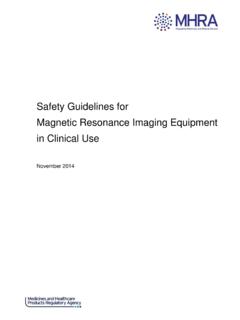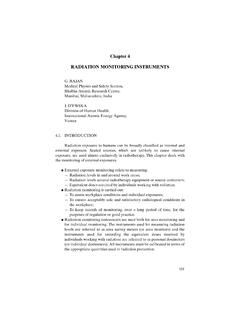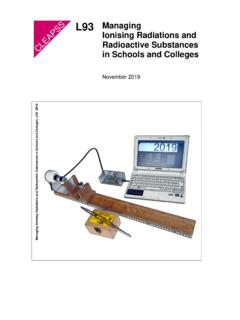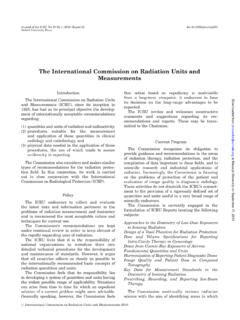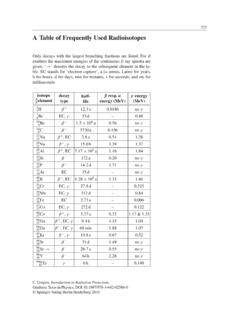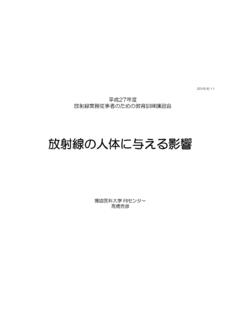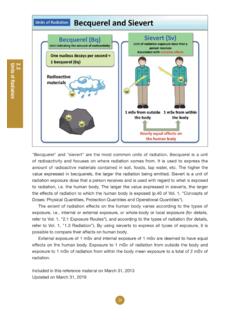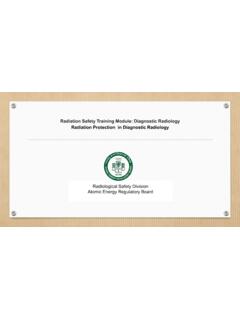Transcription of Safety Guidelines for Magnetic Resonance Imaging ...
1 Safety Guidelines for Magnetic Resonance Imaging Equipment in Clinical Use 1/85 Safety Guidelines for Magnetic Resonance Imaging Equipment in Clinical Use November 2014 Safety Guidelines for Magnetic Resonance Imaging Equipment in Clinical Use 2/85 Acknowledgements The following are acknowledged for their contribution to this document: BAMRR BIR MR committee British Chapter ISMRM HSE IPEM MR SIG Metrasens Ltd SCoR Siemens Philips Medical GE Medical S. Keevil T. Gilk T. O. Woods Mr D Grainger, Medicines and Healthcare Products Regulatory Agency, London Revision history This version Date published Changes November 2014 Text changed since 3rd edition is in dark blue.
2 Crown copyright. Published by the Medicines and Healthcare Products Regulatory Agency Safety Guidelines for Magnetic Resonance Imaging Equipment in Clinical Use 3/85 Contents 1 Introduction .. 5 Background .. 5 Formatting .. 5 Defined terms .. 6 2 The hazards in MRI .. 7 Introduction .. 7 Static Magnetic fields (B0) .. 9 Time-varying Magnetic field gradients (dB/dt) .. 11 Radiofrequency Magnetic fields (B1) .. 12 Acoustic noise .. 14 Pregnancy and MR 15 Cryogens .. 16 Other hazards .. 17 3 Exposure limits and guidance .. 18 Introduction .. 18 Patients, volunteers and carers exposure.. 18 Occupational exposure limits in MR .. 19 Exposure limits for general public.
3 20 4 Management of MR units .. 21 Responsibility and organisation .. 21 Control of access .. 23 Categories of exposed persons .. 23 MR CONTROLLED ACCESS 24 MR ENVIRONMENT .. 25 MR PROJECTILE ZONE .. 26 MR AUTHORISED PERSONNEL .. 26 MR OPERATOR .. 28 Control of equipment taken into the MR ENVIRONMENT .. 28 Patient/volunteer management clinical considerations .. 29 Implanted medical devices and other contraindications to scanning .. 31 Patient/volunteer management scan preparation .. 37 Management of patients when scanning in the CONTROLLED 41 Anaesthesia .. 42 Record of scans .. 43 Contrast media and anti-spasmodics .. 43 Training .. 45 Special issues management of mobile MRI equipment.
4 48 Special issues management of open systems .. 49 Special issues management of interventional units .. 49 Special issues management of radiotherapy planning units .. 50 Other Health and Safety 50 Safety Guidelines for Magnetic Resonance Imaging Equipment in Clinical Use 4/85 5 Equipment Management .. 52 Procurement .. 52 Installation .. 53 Commissioning and acceptance .. 55 MR suite recommendations .. 56 Potential equipment failure .. 59 Emergency procedures .. 61 Planning for replacement .. 63 Appendix 1 Cryogens and venting issues .. 64 Cryogens .. 64 The Pressure Systems Safety Regulations (PSSR) .. 66 Basic guide to installation and specification of quench piping.
5 67 Appendix 2 Exposure limits .. 69 Patients, volunteers and carers exposure limits .. 69 Occupational exposure limits in MR .. 73 Exposure limits for general public .. 74 Appendix 3 Skills for health .. 76 HCS MR1: Develop Safety framework for Magnetic Resonance Imaging .. 76 Appendix 4 Incidents to report to MHRA .. 77 Device Failures .. 77 Defective Medicines .. 77 Side effect with a medicine .. 77 Appendix 5 Example labels .. 78 Websites list .. 79 References .. 80 Safety Guidelines for Magnetic Resonance Imaging Equipment in Clinical Use 5/85 1 Introduction Background This is the 4th edition of the Safety Guidelines and aims to provide relevant Safety information for users of Magnetic Resonance Imaging (MRI) equipment in clinical use but will have some relevance in academic settings and to users of laboratory MR equipment.
6 This guidance is intended to: bring to the attention of those involved with the clinical use of such equipment important matters requiring careful consideration before purchase and after installation of equipment be an introduction for those who are not familiar with this type of equipment and act as a reminder for those who are act as a reminder of the legislation and published guidance relating to this equipment draw the attention of the users to the guidance published by relevant organisations. Reflect current risks and hazards. draw on the experience of MHRA and contributing organisations on safe use of MRI equipment. This document provides general guidance on good practice.
7 Following the guidance is not compulsory and other actions may be equally valid. Formatting Warnings and caution Recommendations Text changed since 3rd edition is in dark blue. Defined terms are in SMALL CAPITALS. Links are formatted in blue. Recommended reading / reference Text reproduced from other MHRA documents Safety Guidelines for Magnetic Resonance Imaging Equipment in Clinical Use 6/85 Defined terms The following terms are used in this document: MR ENVIRONMENT MR CONTROLLED ACCESS AREA MR PROJECTILE ZONE MR_SAFE MR_CONDITIONAL MR_UNSAFE MR AUTHORISED PERSON AUTHORISED PERSON (NON-MR ENVIRONMENT) AUTHORISED PERSON (MR ENVIRONMENT) AUTHORISED PERSON (SUPERVISOR) MR OPERATOR MR RESPONSIBLE PERSON MR Safety EXPERT Safety Guidelines for Magnetic Resonance Imaging Equipment in Clinical Use 7/85 2 The hazards in MRI Introduction During MRI diagnostic Imaging and spectroscopy, individuals being scanned and those in the immediate vicinity of the equipment can be exposed to three variants of Magnetic fields simultaneously.
8 The static Magnetic field (B0) time-varying Magnetic field gradients (dB/dt) radiofrequency (RF) Magnetic fields (B1). The hazards of each of these are discussed separately in the following sections , and Users of superconducting magnets will also be at risk from cryogen hazard. This is discussed in Appendix 1. Published guidance on Safety limits of exposure In the UK, The Centre for radiation , Chemical and Environmental Hazards, part of Public Health England, (formerly part of the Health protection Agency (HPA) (formerly the National Radiological protection Board (NRPB))) publishes guidance on exposure to Magnetic fields. Publications to date are: protection of Patients and Volunteers Undergoing MRI Procedures [1] was published in 2008 and reviews the guidance published by ICNIRP in 2004 [12].
9 Occupational and general public exposure to static and time-varying electromagnetic fields (EMF) guidance in 2004 [2] the risk of cancer from extremely low frequency EMF exposure guidance 1992 [3] and 2002 [4]. As experience is gained, recommendations regarding acceptable levels of exposure may change. If in doubt, seek advice on the current recommendations from the Centre for radiation Chemical and Environmental Hazards at Public Health England. The international Electrotechnical commission (IEC) provides a standard (IEC 60601-2-33) for manufacturers of MRI equipment to follow. This standard focuses on the Safety requirements of MRI equipment used for medical diagnosis. It is a comprehensive source of information on the limits incorporated by manufacturers into their systems design.
10 The third edition to this standard was published in 2010 [5] replacing the second edition from 2002 [6] The international commission on Non-Ionizing radiation protection (ICNIRP) published guidance on time-varying electromagnetic fields in 1998 [7,8], exposure to static fields in 2009 [9], on low frequency fields on 2010 [10] and electric fields induced by movement in 2014 [11]. This guidance is for occupational and general public exposure. For MRI clinical exposure to patients, ICNIRP published a statement in 2004 [12] and an update in 2009 [13]. MR Safety marking ASTM international s standard F2503 [14] for the marking of devices brought into the MR environment should be used.

